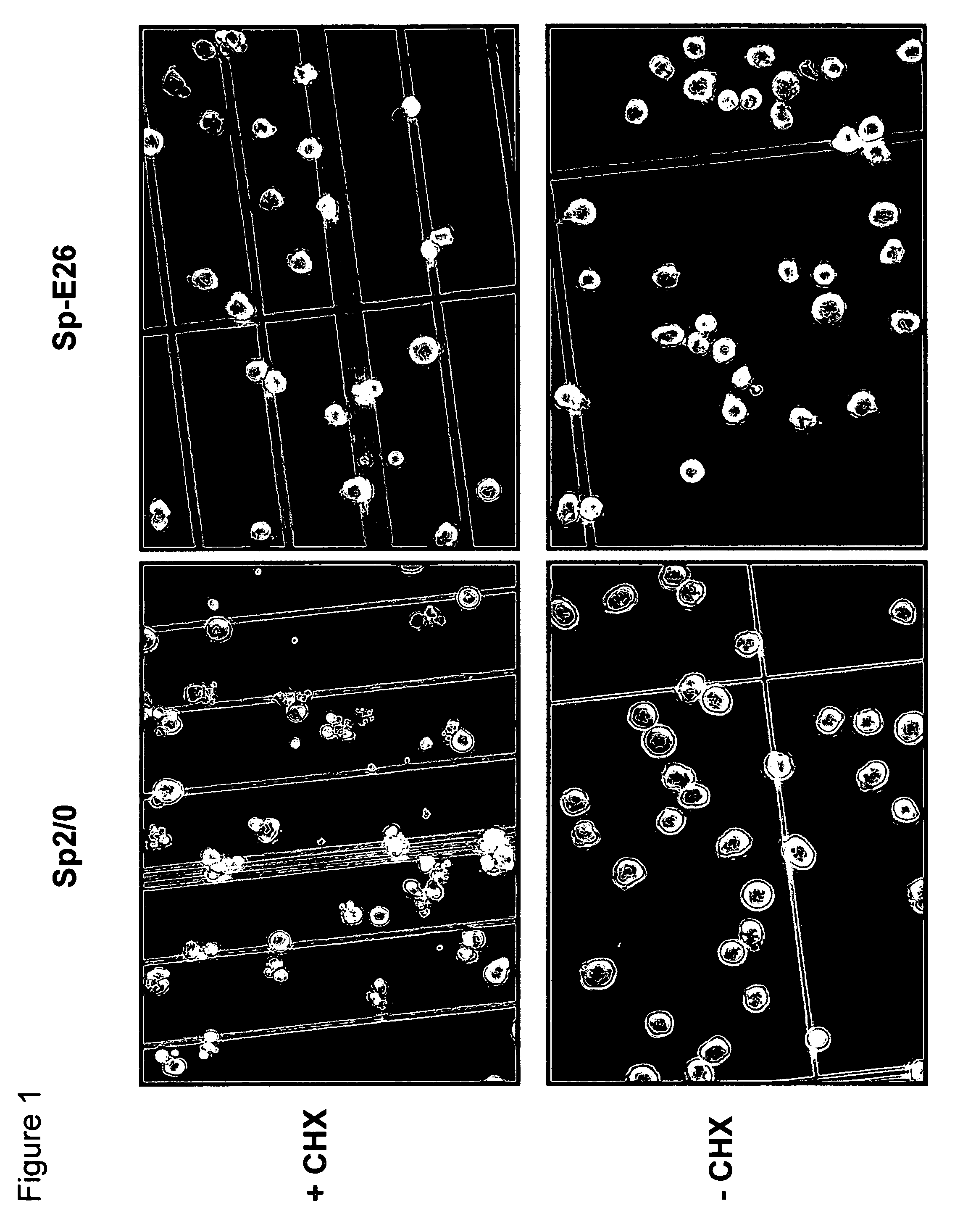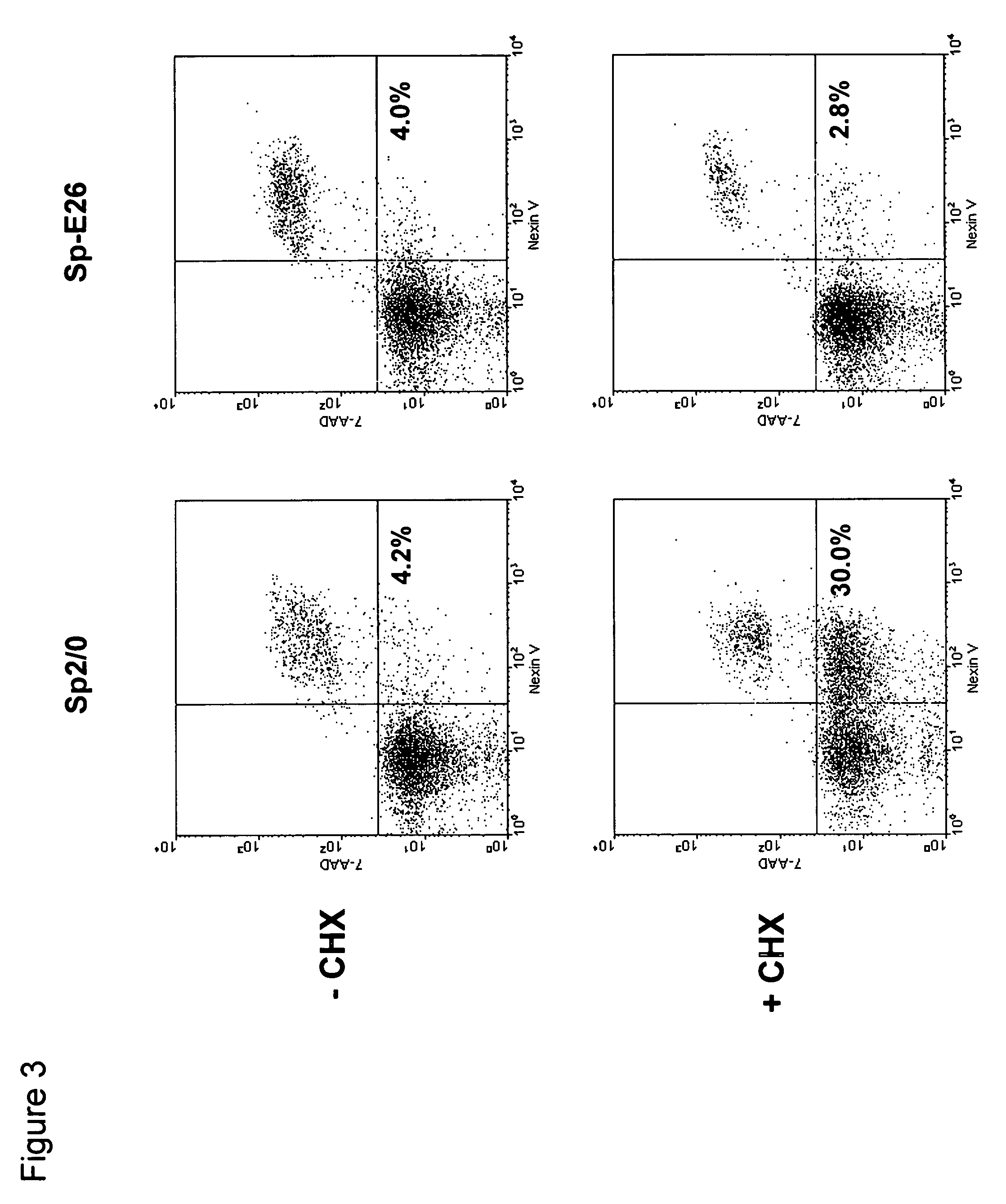Methods and compositions for increasing longevity and protein yield from a cell culture
a cell culture and protein technology, applied in the field of cell culture methods and compositions, can solve the problems of unpredictable results and reduce the lifespan of cells in culture, and achieve the effects of increasing the longevity and recombinant protein yield of cells, promoting cell survival, and increasing cell lifespan and viability
- Summary
- Abstract
- Description
- Claims
- Application Information
AI Technical Summary
Benefits of technology
Problems solved by technology
Method used
Image
Examples
example 1
Generation of Apoptosis-Resistance Cell Clones by Stable Expression of HPV-16 E6 and E7 Genes
Selection of Cell Clones Resistant to CHX Treatment
[0051]Sp2 / 0 cells were transduced with an LXSN retroviral vector containing the expression cassette of HPV-16 E6 and E7 genes at an MOI (multiple of infection) of 10:1. After recovery for 24 h, the infected cells were selected in G418 (1000 μg / ml) for 10 days. G418-resistant cells were cloned in 96-well cell culture plates by limiting dilution (0.5 cells / well). Stable infectants were screened for resistance to treatment by cycloheximide (CHX), a potent apoptosis-inducing agent. Briefly, healthy cells (viability >95%, FIGS. 1C and D) were incubated in medium containing 25 μg / ml of CHX and cell morphology was examined under a microscope. While more than 50% of parent Sp2 / 0 cells underwent morphology change after two to three hours of incubation and became fragmented (FIG. 1A), several E6 / E7 transfected clones showed less extent of morphology c...
example 2
Generation of Apoptosis-Resistance Cell Clones by Stable Over-Expression of HPV16 E7 Gene
[0057]The structure of the poly-cistronic HPV 16 E6 and E7 genes integrated into the genome of clone Sp-E26 was analyzed by PCR using the primer pair E6-N8+(5′-ATG TTT CAG GAC CCA CAG GAG CGA-3′; SEQ ID NO: 8) and E7-C8−(5′-TTA TGG TTT CTG AGA ACA GAT GGG-3′; SEQ ID NO: 9) and DNA sequencing. Since the sequences of primer E6-N8+ and E7-C8− match with the coding sequence for the N-terminal 8 amino acid residues of E6 and the complement sequence for the C-terminal 8 codons of E7, respectively, the amplicon of full-length E6 and E7 is expected to be ˜850 bp. However, amplification of the genomic DNA prepared from Sp-E26 cell with E6-N8+ and E7-C8− resulted a PCR fragment of only ˜700 bp. DNA sequencing of the 700 bp PCR product revealed a deletion of a 182 poly-nucleotide fragment from the E6 gene. The defective E6 gene is likely resulted from splicing and encodes a truncated E6 peptide with N-term...
example 3
High-Level Expression of hLL2 IgG in Sp-E26
[0067]In this example, Sp-E26 is used as a host to generate cell clones producing hLL2, a humanized anti-CD22 Ab developed for treating patients with NHL and autoimmune diseases. An hLL2-producing clone, 87-2-C9, was previously generated by using Sp2 / 0 cell as a host (Losman et al., Cancer 80, 2660-2666, 1997), in which case, only one positive clone (a frequency of ˜2.5×10−7) was identified after transfection, and the maximum productivity (Pmax), defined as the concentration of the antibody in conditioned terminal culture medium in T-flask, of the only hLL2-producing clone, before amplification, was 1.4 mg / L. Transfection of Sp-E26 cell with the same hLL2pdHL2 vector and by using similar procedures as described by Losman et al. (Cancer 80, 2660-2666, 1997) resulted in more than 200 stable hLL2-producing clones, a frequency of >10−4). The Pmax of 12 randomly selected clones was evaluated and found to be between 13 and 170 mg / L, with a mean o...
PUM
| Property | Measurement | Unit |
|---|---|---|
| concentration | aaaaa | aaaaa |
| density | aaaaa | aaaaa |
| cell density | aaaaa | aaaaa |
Abstract
Description
Claims
Application Information
 Login to View More
Login to View More - R&D
- Intellectual Property
- Life Sciences
- Materials
- Tech Scout
- Unparalleled Data Quality
- Higher Quality Content
- 60% Fewer Hallucinations
Browse by: Latest US Patents, China's latest patents, Technical Efficacy Thesaurus, Application Domain, Technology Topic, Popular Technical Reports.
© 2025 PatSnap. All rights reserved.Legal|Privacy policy|Modern Slavery Act Transparency Statement|Sitemap|About US| Contact US: help@patsnap.com



